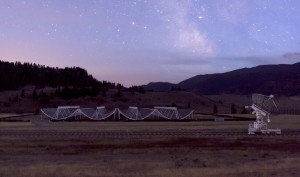McGill University | National Research Council Canada | 2017 Sep 07
Radio telescope will help the world’s astronomers, physicists and scientists unravel today’s biggest cosmic mysteries
[img3=""]https://www.canada.ca/content/canadasit ... 110894.jpg[/img3][hr][/hr]A Canadian effort to build one of the most innovative radio telescopes in the world will open the universe to a new dimension of scientific study. The Honourable Kirsty Duncan, Minister of Science, today installed the final piece of this new radio telescope, which will act as a time machine allowing scientists to create a three-dimensional map of the universe extending deep into space and time.
The Canadian Hydrogen Intensity Mapping Experiment, known as CHIME, is an extraordinarily powerful new telescope. The unique “half-pipe” telescope design and advanced computing power will help scientists better understand the three frontiers of modern astronomy: the history of the universe, the nature of distant stars and the detection of gravitational waves
By measuring the composition of dark energy, scientists will better understand the shape, structure and fate of the universe. In addition, CHIME will be a key instrument to study gravitational waves, the ripples in space-time that were only recently discovered, confirming the final piece of Einstein’s theory of general relativity. ...
Canadian Ingenuity Crafts Technology for CHIME Telescope
Dunlap Institute for Astronomy & Astrophysics | Toronto University | 2017 Sep 07
CHIME, the revolutionary Canadian radio telescope inaugurated today in British Columbia, incorporates creative technology that will enable it to simultaneously tackle major astrophysics and cosmology topics — including studying the nature of “dark energy” by making unprecedented maps of the distant Universe, and determining the origin of the mysterious phenomenon known as Fast Radio Bursts.
Unlike traditional telescopes, CHIME (short for the Canadian Hydrogen Intensity Mapping Experiment) has no moving parts. The telescope, produced by 50 scientists from the University of British Columbia, the University of Toronto, McGill University, and the National Research Council of Canada “sees” the radio sky in a novel way: It uses over a thousand antennas to record the information from all the radio waves falling across its surface.
The radio signals are converted to digital data at a rate of 13 terabits per second – comparable to the entire world’s mobile data rate. This amount of information can’t be stored, so it is processed in real time. With these techniques, CHIME is able to digitally “point” anywhere within a wide stripe of sky overhead, making traditional telescope steering unnecessary. More importantly, it is able to look in many different directions simultaneously. ...
Dominion Radio Astrophysical Observatory (DRAO)
Canadian Hydrogen Intensity Mapping Experiment (CHIME)
